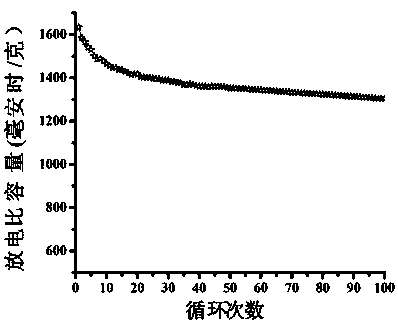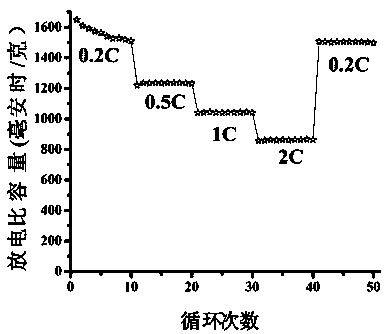Ternary metal oxide composite MXene material and application thereof to lithium-sulfur batteries
A ternary metal and composite material technology, applied in the field of material chemistry, can solve the problems of specific capacitance and capacitance to be improved, and achieve the effect of large volume expansion buffer space, multiple buffer spaces, and increased stability
- Summary
- Abstract
- Description
- Claims
- Application Information
AI Technical Summary
Problems solved by technology
Method used
Image
Examples
Embodiment 1
[0026] (1) Preparation of MXene:
[0027] Immerse the ground MAX phase ceramic powder in HF solution with a mass fraction of 40%, the mass ratio of ceramic powder to HF solution is 1:20, heat up to 80°C, stir magnetically for 18 hours, then centrifuge to obtain the product, and use deionized Wash with water until neutral, and dry in an oven at 70°C for 18 hours to obtain MXene. The MAX phase ceramic is Ti 3 AlC 2 . Get MXene material as Ti 3 C 2 T x ,T x For -OH, -F and other functional groups.
[0028] (2) Preparation of NiCo 2 o 4 -MXene composites:
[0029] Take 1.5g of MXene prepared in step (1), 0.8g of nickel acetate, and 0.8g of cobalt acetate, put them in 120mL of deionized water, stir well, then transfer the mixed solution to a 200mL reaction kettle, raise the temperature to 160°C, and keep it warm for 8 Hour. After cooling in the oven, the product was obtained by centrifugation, washed repeatedly with deionized water, and dried in an oven at 60°C for 12 h...
Embodiment 2
[0035] (1) Preparation of MXene:
[0036] Immerse the ground MAX phase ceramic powder in HF solution with a mass fraction of 30%, the mass ratio of ceramic powder to HF solution is 1:30, heat up to 50°C, stir magnetically for 12 hours, then centrifuge to obtain the product, and use deionized Wash with water until neutral, and dry in an oven at 60°C for 12 hours to obtain MXene. The MAX phase ceramic is Ti 3 AlC 2 . Get MXene material as Ti 3 C 2 T x ,T x For -OH, -F and other functional groups.
[0037] (2) Preparation of NiCo 2 o 4 -MXene composites:
[0038] Take 1 g of MXene prepared in step (1), 0.5 g of nickel acetate, and 0.5 g of cobalt acetate, put them in 100 mL of deionized water, stir well, then transfer the mixed solution to a 200 mL reaction kettle, raise the temperature to 150 ° C, and keep it warm for 6 hours. After cooling in the oven, the product was obtained by centrifugation, washed repeatedly with deionized water, and dried in an oven at 60°C for...
Embodiment 3
[0042] (1) Preparation of MXene:
[0043] Immerse the ground MAX phase ceramic powder in HF solution with a mass fraction of 50%, the mass ratio of ceramic powder to HF solution is 1:10, heat up to 90°C, stir magnetically for 24 hours, then centrifuge to obtain the product, and use deionized Wash with water until neutral, and dry in an oven at 80°C for 24 hours to obtain MXene. The MAX phase ceramic is Ti 3 AlC 2 . The obtained MXene material can be Ti 3 C 2 T x ,T x For -OH, -F and other functional groups.
[0044] (2) Preparation of NiCo 2 o 4 -MXene composites:
[0045] Take 2g of MXene prepared in step (1), 1g of nickel acetate, and 1g of cobalt acetate, put them in 150mL of deionized water, stir well, then transfer the mixed solution to a 200mL reaction kettle, raise the temperature to 180°C, and keep it warm for 12 hours. After cooling in the oven, the product was obtained by centrifugation, washed repeatedly with deionized water, and dried in an oven at 60°C ...
PUM
 Login to View More
Login to View More Abstract
Description
Claims
Application Information
 Login to View More
Login to View More - R&D
- Intellectual Property
- Life Sciences
- Materials
- Tech Scout
- Unparalleled Data Quality
- Higher Quality Content
- 60% Fewer Hallucinations
Browse by: Latest US Patents, China's latest patents, Technical Efficacy Thesaurus, Application Domain, Technology Topic, Popular Technical Reports.
© 2025 PatSnap. All rights reserved.Legal|Privacy policy|Modern Slavery Act Transparency Statement|Sitemap|About US| Contact US: help@patsnap.com


